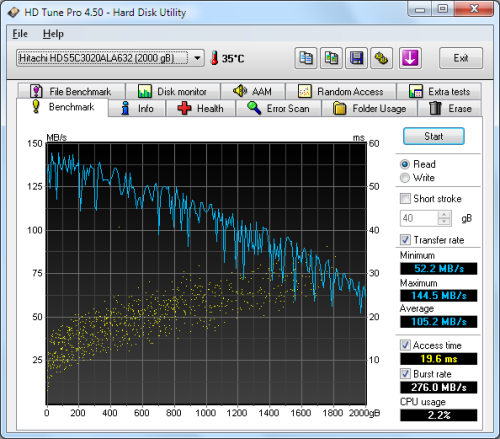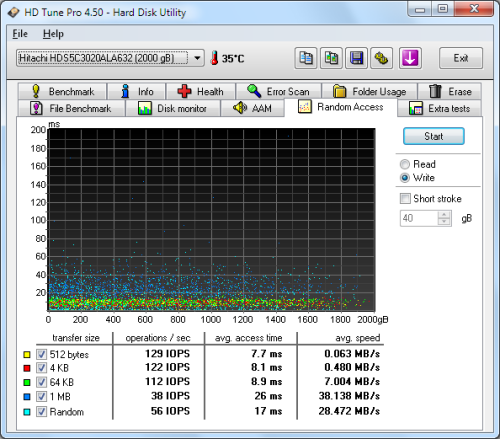

Model: Hitachi Deskstar 5K3000 2TB Hard Drive
Manufacturer: Hitachi Global Storage Technologies
Provided By: Reader Donations
Hitachi Global Storage Technologies (Hitachi GST) is one of the biggest names in the storage industry. Founded in 2003, the company was the result of a merger between IBM and Hitachi’s hard drive businesses. Building upon the technologies and expertise of these two industry pioneers, Hitachi GST has grown to become the world's third largest hard drive manufacturer. The company currently offers a wide range of products for the consumer and enterprise markets, including its popular Deskstar family of hard drives.
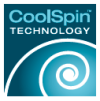 The latest additions to Hitachi's Deskstar family are the 7K3000 and 5K3000. Both models are available in 1.5TB, 2TB and 3TB capacities and are the first from the company to offer a SATA 6 Gb/s interface. From here though, the similarities end. Where the performance oriented 7K3000 sports a 64GB cache and spins at 7,200 RPM, the 5K3000 was designed with power efficiency and quiet operation in mind. The drive uses Hitachi's CoolSpin technology uses a motor speed optimized to provide an ideal balance of performance, power utilization and acoustics. When combined with Hitachi's other power management techniques, CoolSpin technology delivers up to 29 percent lower power and 14 percent quieter acoustics than the Deskstar 7K3000.
The latest additions to Hitachi's Deskstar family are the 7K3000 and 5K3000. Both models are available in 1.5TB, 2TB and 3TB capacities and are the first from the company to offer a SATA 6 Gb/s interface. From here though, the similarities end. Where the performance oriented 7K3000 sports a 64GB cache and spins at 7,200 RPM, the 5K3000 was designed with power efficiency and quiet operation in mind. The drive uses Hitachi's CoolSpin technology uses a motor speed optimized to provide an ideal balance of performance, power utilization and acoustics. When combined with Hitachi's other power management techniques, CoolSpin technology delivers up to 29 percent lower power and 14 percent quieter acoustics than the Deskstar 7K3000.
For this review, we chose the 2TB version of the Deskstar 5K3000. This drive can be purchased for less than $80 online, which is about half the cost of the 3TB version. The 2TB Deskstar 5K3000 also has only three platters, which makes it slightly quieter than the five platter 3TB drive.
| Hitachi Deskstar 5K3000 2TB Hard Drive | |||||||||||||||||||||||||||||||||
General Specifications
Performance
Environmental
Dimensions and Weight
Other Features
|
Needless to say, this is only a taste of what the Deskstar 5K3000 has to offer. To give you an idea of what to expect, we'll take a closer look at Hitachi's new low power hard drive and then see how well it performs. Does the Deskstar 5K3000 have what it takes? More importantly, is it the best bang for your buck? Keep reading as we find out.

Hitachi does offer the Deskstar 5K3000 in a retail kit. However, you can save about $30-$40 by buying the bulk, or OEM, version of the drive. If you choose to go this route, the Deskstar 5K3000 will come in a sealed, antistatic bag.
Physical Features:
The 2TB version of the Deskstar 5K3000 looks very similar to Hitachi's previous CoolSpin hard drives. It shares the same basic label design as well as a top cover that's nearly identical to the one on the 5K1000.
 |
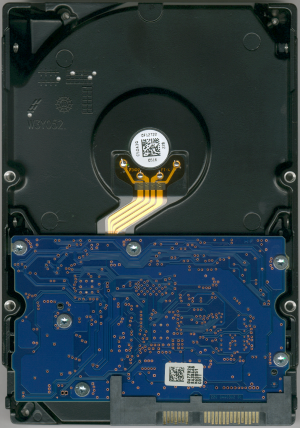 |
It's not until you look at the bottom that you can see a real difference between the 5K3000 and Hitachi's previous CoolSpin hard drives. The circuit board is not only larger on the 5K3000, but the chips are facing the body of the drive. This helps protect the components and keep them cool by putting them in direct contact with the metal body.

Along the front, you can see the 5K3000's SATA data and power connectors. The drive also has a pair of jumpers which I could not find any reference to in the manual. However, with earlier drives, this jumper was used to enable the Power Up In Standby mode.
The test system used in this review was an HP dc7900. The computer came equipped with an Intel Core 2 Duo E8400 3.0GHz CPU, 2GB of DDR2 800MHz memory, Seagate Barracuda 7200.10 ST3250310AS 250GB SATA hard drive, NVIDIA Quadro FX570 256MB PCIe graphics card, Intel 82567LM-3 gigabit network card and HighPoint Rocket 620 SATA 6Gb/s controller. For the operating system, I installed a fresh copy of Windows 7 Enterprise.
To test the performance of the Hitachi Deskstar 5K3000, I ran a series of benchmarks using CrystalDiskMark 3.0, HD Tach RW 3.0.4.0, ATTO Disk Benchmark 2.46 and HD Tune Pro 4.50.
CrystalDiskMark 3.0:
First, I ran a few quick tests using CrystalDiskMark. This benchmark tool measures the performance of a storage device by testing its sequential read and write speeds as well as its random read and write speeds using blocks 512K and 4K in size.
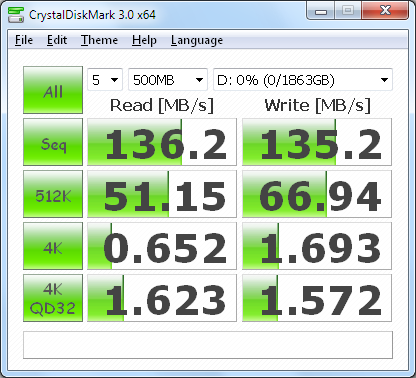
Hitachi doesn't really say what kind of speeds the Deskstar 5K3000 is capable of. Using CrystalDiskMark we can see that the drive is able to read at 136 MB/s and write at 135 MB/s.
HD Tach RW 3.0.4.0:
Next, I used HD Tach to test the Hitachi Deskstar 5K3000's read, write and burst speeds as well as its seek times and CPU usage.
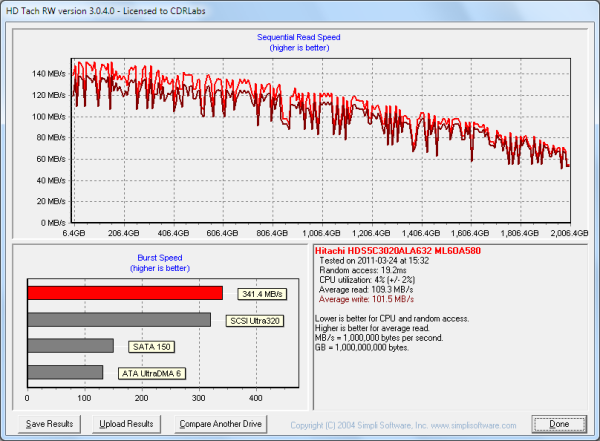
The Deskstar 5K3000 performed very well when tested with HD Tach. Looking at the screenshot above, you can see that the drive had average read and write speeds of 109.3 MB/s and 101.5 MB/s, respectively, as well as a burst speed of 341.4 MB/s.
ATTO Disk Benchmark 2.46:
I also used ATTO Disk Benchmark to test the Hitachi Deskstar 5K3000's sequential read and write speeds. The test was run using blocks ranging in size from 0.5KB to 8192KB and the total length set to 256MB.
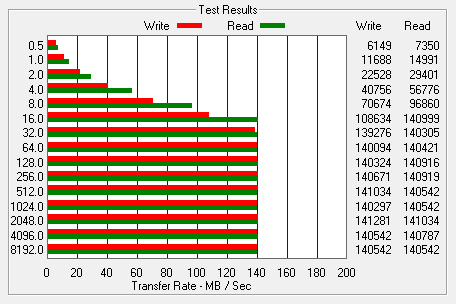
When tested with ATTO, the Deskstar 5K3000's read and write speeds topped out at about 141 MB/s.
HD Tune Pro 4.50:
Next, I ran a series of tests using HD Tune Pro. This hard disk utility measures a drive's performance by testing its sequential read and write speeds as well as its access time, burst rate and CPU usage. For this review, I used it to benchmark the Hitachi Deskstar 5K3000's random read and write speeds, random access times and the number of operations per second.
The performance here was very similar to what we saw with HD Tach. The Deskstar 5K3000 had average read and write speeds of 105.2 MB/s and 103.6 MB/s, respectively, and a burst rate of about 275 MB/s. The drive's access times were a little high. However, this is primarily due to its slower rotational speed.
While no match for the SSDs we've looked at recently, the Deskstar 5K3000's random read and write performance is on par with other low-power hard drives.
Final Thoughts:
The Hitachi Deskstar 5K3000 is an excellent choice for anyone looking to add a low-power, high capacity hard drive to their HTPC, home server or desktop computer. Thanks to technologies like HiVERT and CoolSpin, the 5K3000 uses less power and is quieter than drives with a 7,200 RPM rotational speed. Of course, as with any low power hard drive, there is some trade off in regards to performance. The 5K3000's slower rotational speed did have a negative impact on its access times. However, the drive still performed surprisingly well in our tests, reading and writing at speeds in excess of 135MB/s.
The Hitachi Deskstar 5K3000 is available now in 1.5TB, 2TB and 3TB capacities. The 2TB version reviewed here currently runs about $80. However, it can often be found for as little as $70 through Newegg and Amazon. Expect to pay a premium for the 3TB version of the drive though, which can be purchased from Amazon or through some of the vendors on PriceGrabber for about $150.
Highs:
- Available in 1.5TB, 2TB and 3TB capacities
- SATA 6Gb/s interface
- Good read and write speeds
- Power efficient
- Quiet operation
- 32MB cache
- Affordably priced
- 3 year warranty
Lows:
- High access times
